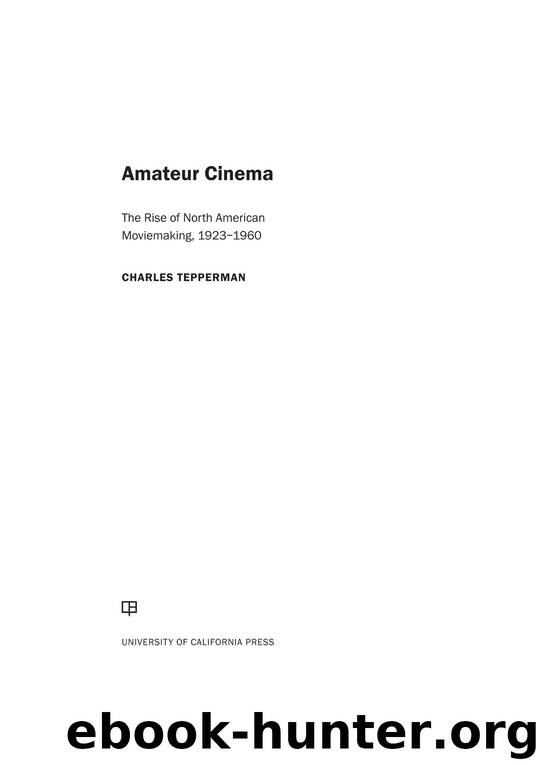Amateur Cinema by Tepperman Charles

Author:Tepperman, Charles [Tepperman, Charles]
Language: eng
Format: epub
ISBN: 9780520279858
Publisher: University of California Press
Published: 0101-01-01T00:00:00+00:00
COMMUNITY CHRONICLE FILMS: ANOTHER DAY (LESLIE THATCHER)
While family was their most frequent subject, many amateur filmmakers looked beyond their own domestic spaces to produce movies that chronicled local public events and surroundings. As they did with family films, amateurs drew from a variety of different aesthetic influences to creatively shape their filmed records of the world. In theory, the source material for this kind of filming was limitless, but in practice, amateurs returned to several common themes often, including local sporting events, urban spaces, and community parades and carnivals. Amateur publications routinely offered tips on how to go about this kind of filmmaking, such as this advice for amateurs trying to capture local sports events: “Just as the king’s chronicler of old was privileged to see everything from the best point of vantage, the owner of a movie outfit and a reasonable amount of nerve is almost sure of a preferred position at the side line, if only he takes care to get acquainted with the players and to offer them, in return for the courtesy, a screening of the results at their convenience.”16 This advice provides a multidimensional view of the amateur: not only is the filmmaker recording an event for himself, but also as a member of a community he presents his film to the subjects and participants as well. This makes his position different from the commercial newsreel cameraman, who might offer little in return for the favor of filming an event. And for some amateurs, the idea of a king’s chronicler was one they took literally: in May 1939, King George’s visit to Canada resulted in a handful of amateur movie productions. In Toronto, members of the local amateur movie clubs banded together to produce Toronto’s Royal Day, a Kodachrome chronicle of the king and queen’s tour. In both their cooperative production method and their civic subject matter, these amateurs constituted a significant public film culture.17
World’s fairs and similar pageants marked another important subject for amateur chronicles, mixing the appeal of simulated travel with quasi-ethnographic spectacles. The 1933 Chicago World’s Fair combined modernist architecture with “national pageants” from around the world to provide a setting for amateurs to take colorful and exotic views without the requirement of leaving the United States. R. Fawn Mitchell, of the Chicago Cinema Club, advised amateurs on how to select the most appealing and significant aspects of the fair to film, emphasizing in particular the selection of striking visual elements: “First of all, we are struck by the colorful aspect of the Fair—the gala crowd, the modernist buildings and the colorings of these buildings which, even in daytime, are quite vivid. Therefore, probably we will plan to take some Kodacolor pictures.”18 Here, as in many points in the article, Mitchell remarks on the “modernist” aspects of the buildings, which was clearly part of the spirit of the fair and is returned to often in Mitchell’s article. By contrast, Mitchell’s article also recommended the filming of the various “national pageants” or “villages,”
Download
This site does not store any files on its server. We only index and link to content provided by other sites. Please contact the content providers to delete copyright contents if any and email us, we'll remove relevant links or contents immediately.
4 - Harry Potter and the Goblet of Fire by J.K. Rowling(2657)
2010-The City & the City by China Miéville(1945)
Wall and Piece by Banksy(1781)
Thank You for Being Late by Thomas L. Friedman(1739)
The Old Farmer's Almanac 2020 by Old Farmer’s Almanac(1660)
The Mirror and the Light by Hilary Mantel(1633)
Journey to the Abyss by Harry Kessler(1601)
The Andy Warhol Diaries by Andy Warhol(1565)
Tolkien, J. R. R. - The Fellowship of the Ring by Tolkien J. R. R(1496)
Life on Earth by David Attenborough(1433)
Art Nouveau by Carol Belanger Grafton(1397)
The Museum Of Innocence by Orhan Pamuk(1380)
Harry Potter - A History of Magic by British Library(1372)
The Business of Being an Artist by Daniel Grant(1339)
Frida by Hayden Herrera(1280)
The Future Is Japanese by(1271)
Impeach by Neal Katyal(1247)
A History of Japanese Art by Noritake Tsuda(1200)
1215 by Danny Danziger(1162)
